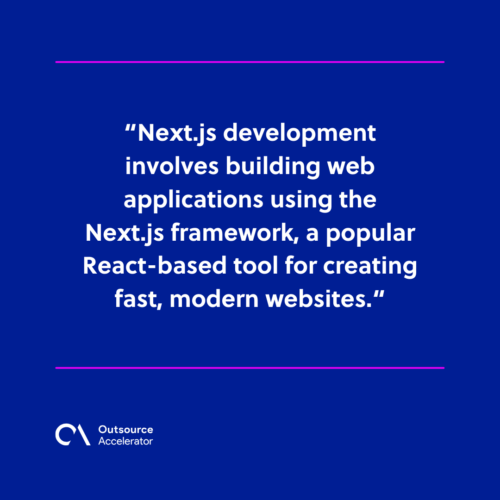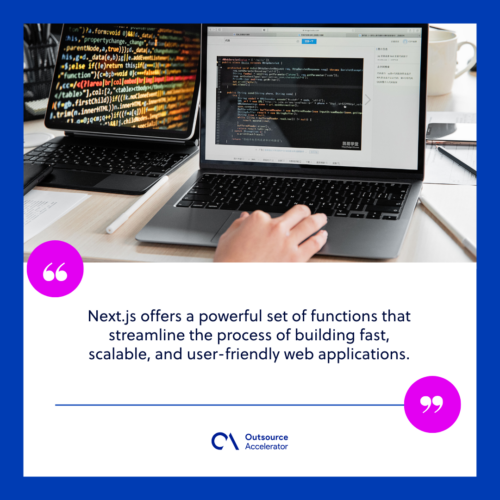Next.js development: Creating scalable and SEO-friendly apps

Creating web applications that are both user-friendly and SEO-optimized is critical in the present digital world. Users expect fast, responsive experiences across all devices, while search engines favor apps that load quickly and follow best practices.
While many frameworks support modern web development, Next.js is rapidly becoming a favorite among developers. Its built-in features help teams build apps that perform well and rank higher.
In this article, we’ll explore what makes Next.js development so effective and why more companies are choosing it for their projects. You’ll also learn how Itransition’s Next.js development services can support your goals, whether you’re launching a new app or improving an existing one.
Discover how to deliver powerful, scalable applications that drive both engagement and visibility.
What is Next.js development?
Next.js development involves building web applications using the Next.js framework, a popular React-based tool for creating fast, modern websites.
Developed by Vercel, Next.js supports both server-side rendering and static site generation, making it a flexible option for various project needs.
At its core, Next.js extends React by adding features that simplify the development process. It handles routing automatically, allowing developers to create pages by adding files to a specific directory. It also supports API routes, letting teams build backend functionality within the same project structure.

When a user visits a page, Next.js decides whether to render it on the server, generate it statically, or use client-side rendering, depending on how the app is configured. This approach helps developers control how content loads and interacts with users.
Next.js development streamlines the workflow for building modern, full-featured web applications by managing both front-end and back-end logic.
Why use Next.js development?
Next.js is now a popular choice for crafting contemporary web applications. It combines performance, flexibility, and developer-friendly features that make it stand out in today’s fast-moving digital world.
Here’s why many teams choose Next.js development:
- Fast performance. Next.js supports server-side rendering and static site generation, helping pages load quickly and respond smoothly.
- SEO optimization. It allows search engines to index content effectively by rendering pages on the server, making websites more discoverable.
- Built-in routing. Developers don’t need to set up complex routing systems. Next.js uses a file-based routing structure that’s simple and efficient.
- Full stack capabilities. With API routes, teams can build both front-end and back-end features within one project.
- Scalability. Next.js works well for both small websites and large enterprise applications, growing with your business needs.
- Developer experience. Features like hot reloading, TypeScript support, and flexible deployment options speed up the build process.
With Next.js development, businesses can deliver high-quality web experiences that meet user expectations and adapt to future demands.
Essential features of Next.js development
Next.js offers a powerful set of functions that streamline the process of building fast, scalable, and user-friendly web applications. It enhances the capabilities of React by adding tools and functions that support better performance, flexibility, and maintainability.
Outlined below are the essential features that make Next.js development stand out:
1. Server-Side Rendering (SSR)
Next.js can render pages on the server before sending them to the browser. SSR results in faster initial page loads and better indexing by search engines, helping websites perform well across devices and platforms.
2. Static Site Generation (SSG)
With SSG, Next.js can generate HTML pages at build time. This reduces server load and delivers blazing-fast page speeds. It’s ideal for blogs, landing pages, and content-heavy sites that don’t require frequent updates.
3. API routes
Next.js allows developers to build backend functionality within the same project using API routes. It simplifies development by eliminating the need for a separate backend service to handle requests and responses.
4. File-based routing
Next.js automatically creates routes based on the file structure in the pages directory. This approach makes navigation intuitive and reduces the need for manual configuration.
5. Image optimization
Built-in image optimization tools help deliver responsive, high-quality images without slowing down load times. Next.js supports automatic resizing, lazy loading, and modern formats.
6. Incremental Static Regeneration (ISR)
With ISR, developers can update static content after deployment without needing to rebuild the entire site. Increment Static Regeneration combines the speed of static pages with the flexibility of dynamic content updates.
These features make Next.js development a strong choice for building high-performance, future-ready web applications that deliver exceptional user experiences.

From concept to code: Itransitions’ end-to-end Next.js development services
Itransition transforms ideas into scalable, high-performance web applications with its full-cycle Next.js development services.
This premier software engineering solutions provider is backed by 25+ years of industry expertise. It delivers custom solutions—from plugin development to seamless migrations—tailored to business goals.
With a 4.9 Clutch rating and a strong track record, Itransition stands out as a trusted partner for forward-thinking digital solutions.
Browse Itransition’s Next.js development services to start building your next standout application!







 Independent
Independent




